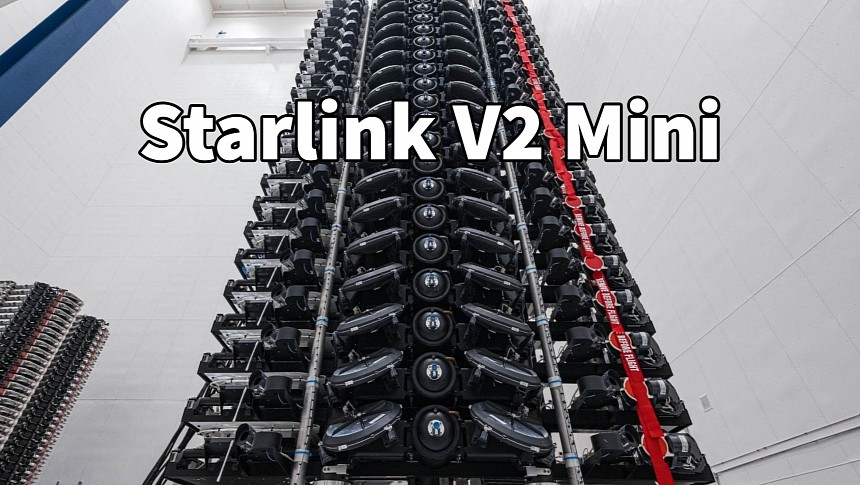Starlink V2 Mini satellites had a rough start after the first batch was launched in February. Still, SpaceX learned from its past mistakes and is now ready to switch on its second-generation Starlink constellation. This should provide a welcome relief to users affected by the capacity issues of Starlink's internet service.
Group 6-1, the first batch of Starlink V2 mini satellites, was launched on February 27. Although the launch was successful, the satellites' trajectories got scientists puzzled. Instead of rising into orbit as expected, they started descending, two of them abruptly. Three weeks later, Elon Musk admitted there were "some issues" with the second-generation satellites due to the new technologies used.
Musk talked about deorbiting some satellites, pointing to a more severe problem. Five of the 21 satellites in this batch have been deorbited, based on data maintained by the astronomer Jonathan McDowell, who's been tracking Starlink satellites. Since Group 6-1 deployed, SpaceX launched three more V2.0 batches, with a total of 86 satellites. Problems appear to have been solved, as Group 6-2 lost only one satellite, with another deorbited from Group 6-4.
In parallel, SpaceX continued to deploy hybrid generation (V1.5) spacecraft, which are updated first-generation Starlink satellites that are still part of the second-generation constellation. They form Group 5, as opposed to the V2.0 spacecraft, which are part of Group 6. SpaceX currently has 492 V1.5 satellites in its second-generation constellation. Only two have been deorbited, confirming the more mature technology.
With enough satellites in orbit, SpaceX is eager to put them to work, and a filing with the FCC shows that it already started exchanging internet data with earth stations with directional antennas located within the US. The brief filing contains only a notification that SpaceX initiated communications between the Gen2 constellation and the earth stations.
It's unclear whether SpaceX already uses the Gen2 constellation to provide commercial services to Starlink users. Nevertheless, if it hasn't already, it will soon start boosting capacity for the high-speed internet connection used all around the world. The Starlink service has become a victim of its popularity as more users signing up resulted in slower internet speeds for everyone.
Although SpaceX has been busy launching more satellites into orbit, it could barely keep up with the number of new users added to the network. SpaceX adds new countries and territories to its coverage map almost on a daily basis. The V2.0 satellites could help alleviate network congestion, but SpaceX doesn't have too many. As we've seen, most satellites in the second-generation constellation are still Starlink V1.5, which offers a more limited data throughput.
SpaceX is probably waiting for Starship's successful testing to deploy the bigger and heavier Starlink V2 satellites (non-Mini) into orbit. This could be one reason why so few V2 Mini satellites have been launched so far. The other is that Falcon 9 can launch up to 56 V1.5 satellites at a time, whereas only 22 V2.0 satellites can be launched using the same system.
Musk talked about deorbiting some satellites, pointing to a more severe problem. Five of the 21 satellites in this batch have been deorbited, based on data maintained by the astronomer Jonathan McDowell, who's been tracking Starlink satellites. Since Group 6-1 deployed, SpaceX launched three more V2.0 batches, with a total of 86 satellites. Problems appear to have been solved, as Group 6-2 lost only one satellite, with another deorbited from Group 6-4.
In parallel, SpaceX continued to deploy hybrid generation (V1.5) spacecraft, which are updated first-generation Starlink satellites that are still part of the second-generation constellation. They form Group 5, as opposed to the V2.0 spacecraft, which are part of Group 6. SpaceX currently has 492 V1.5 satellites in its second-generation constellation. Only two have been deorbited, confirming the more mature technology.
With enough satellites in orbit, SpaceX is eager to put them to work, and a filing with the FCC shows that it already started exchanging internet data with earth stations with directional antennas located within the US. The brief filing contains only a notification that SpaceX initiated communications between the Gen2 constellation and the earth stations.
It's unclear whether SpaceX already uses the Gen2 constellation to provide commercial services to Starlink users. Nevertheless, if it hasn't already, it will soon start boosting capacity for the high-speed internet connection used all around the world. The Starlink service has become a victim of its popularity as more users signing up resulted in slower internet speeds for everyone.
Although SpaceX has been busy launching more satellites into orbit, it could barely keep up with the number of new users added to the network. SpaceX adds new countries and territories to its coverage map almost on a daily basis. The V2.0 satellites could help alleviate network congestion, but SpaceX doesn't have too many. As we've seen, most satellites in the second-generation constellation are still Starlink V1.5, which offers a more limited data throughput.
SpaceX is probably waiting for Starship's successful testing to deploy the bigger and heavier Starlink V2 satellites (non-Mini) into orbit. This could be one reason why so few V2 Mini satellites have been launched so far. The other is that Falcon 9 can launch up to 56 V1.5 satellites at a time, whereas only 22 V2.0 satellites can be launched using the same system.






